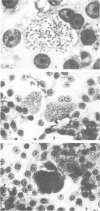Abstract
Methods were developed that allow invasion of sporozoites from simian malaria parasite species (Plasmodium cynomolgi, P. knowlesi, P. coatneyi, P. inui, P. gonderi, P. fragile) and development to schizont stages in rhesus and Saimiri monkey hepatocytes. The P. cynomolgi-rhesus monkey model was used to study inhibition of schizont development using monoclonal antibodies (MAbs) produced against the circumsporozoite (CS) protein of various strains and species of malaria parasites. Immunoelectron microscopy, using gold-labelled MAbs and cultured parasites, demonstrated that the CS protein persists in 7-day old liver stages of P. cynomolgi, but is not expressed at the surface of infected hepatocytes. A rhesus monkey was immunized with autologous hepatocytes (collected by biopsy) infected in vitro with liver stages of P. cynomolgi. This immunization elicited antibodies reacting with sporozoite, liver stage, and blood-stage parasites. In addition, human malaria parasites (P. falciparum, P. vivax, P. malariae) have been cultured in Saimiri or rhesus monkey hepatocytes. The P. vivax-Saimiri monkey model was used to study inhibition activity of sera from Saimiri monkeys experimentally immunized with recombinant P. vivax CS proteins. Post-immunization sera inhibited the parasite development, thus demonstrating the induction of antibodies effective against sporozoites. No relationship, however, was detected between in vitro inhibition and in vivo protection or antibody titres determined by ELISA or IFA.
Full text
PDF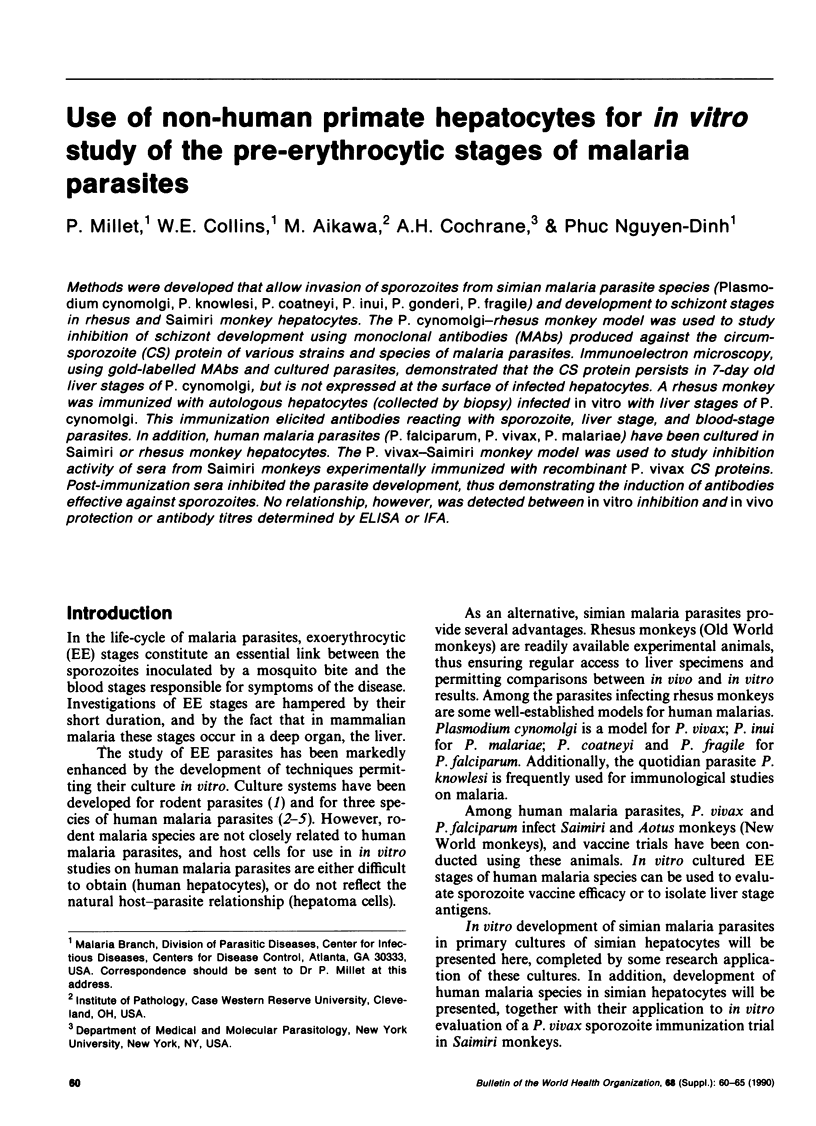
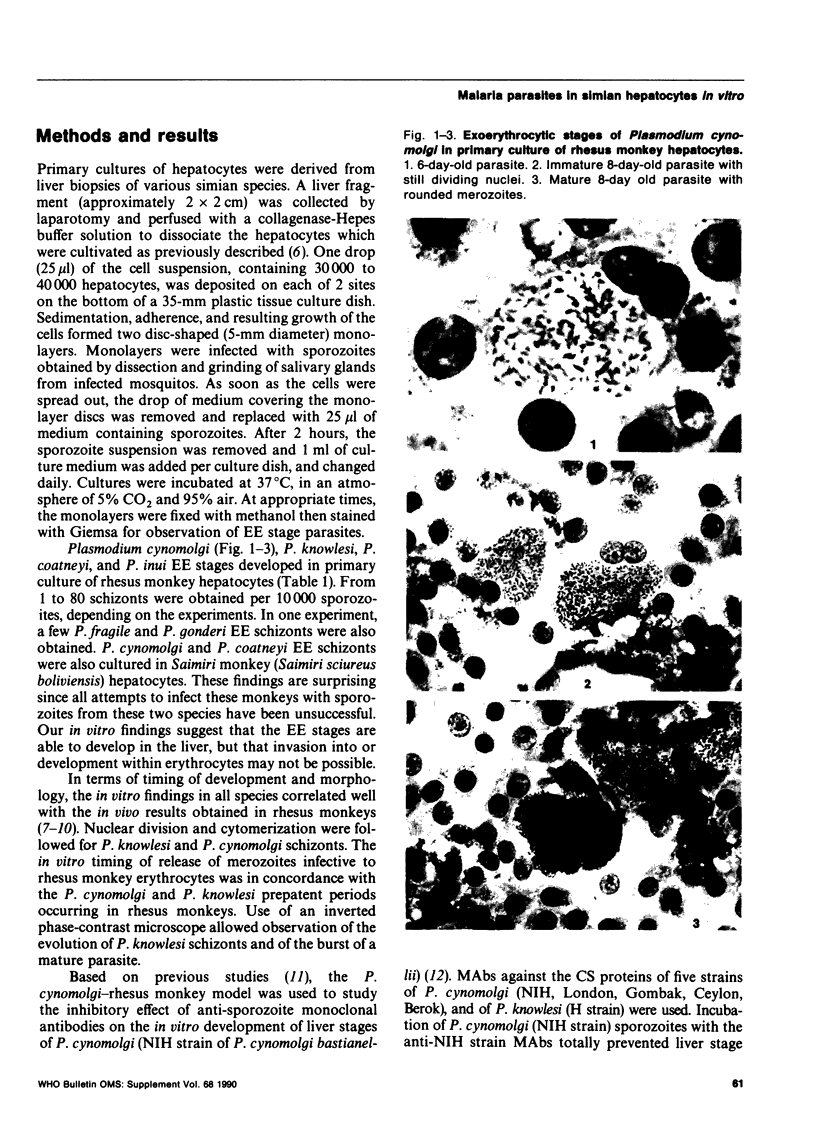
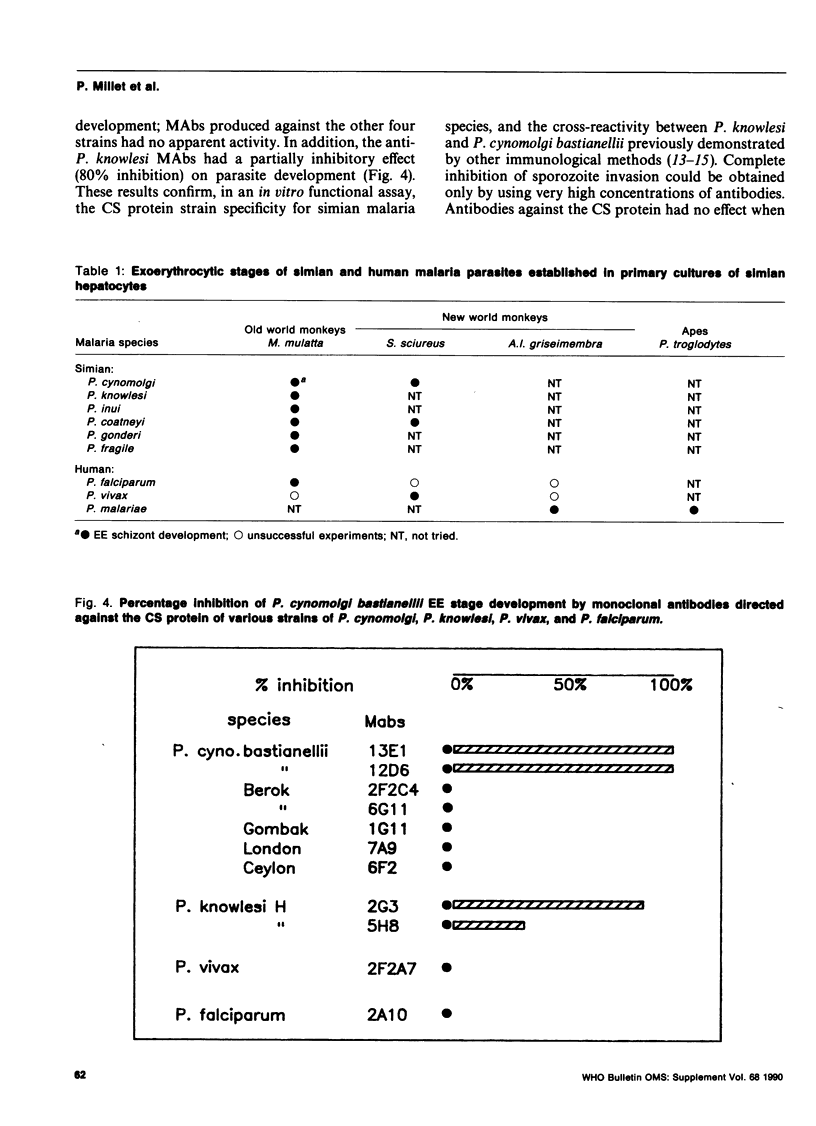
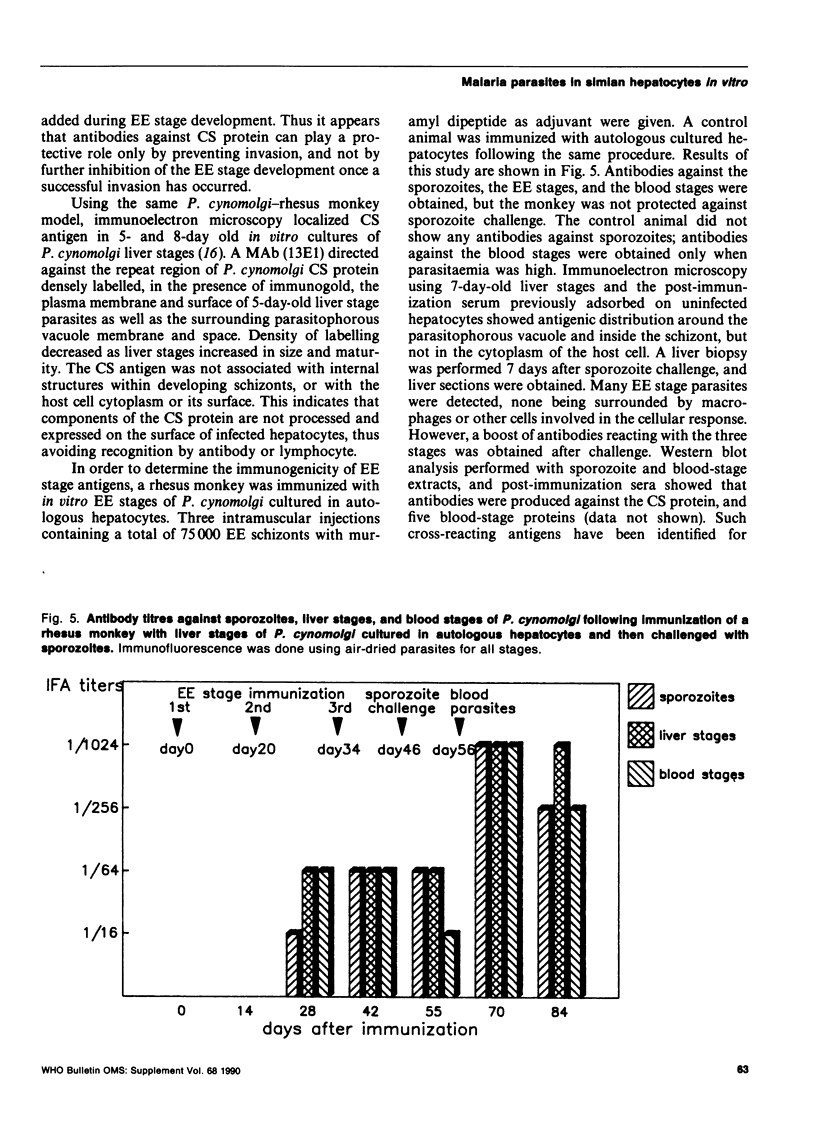
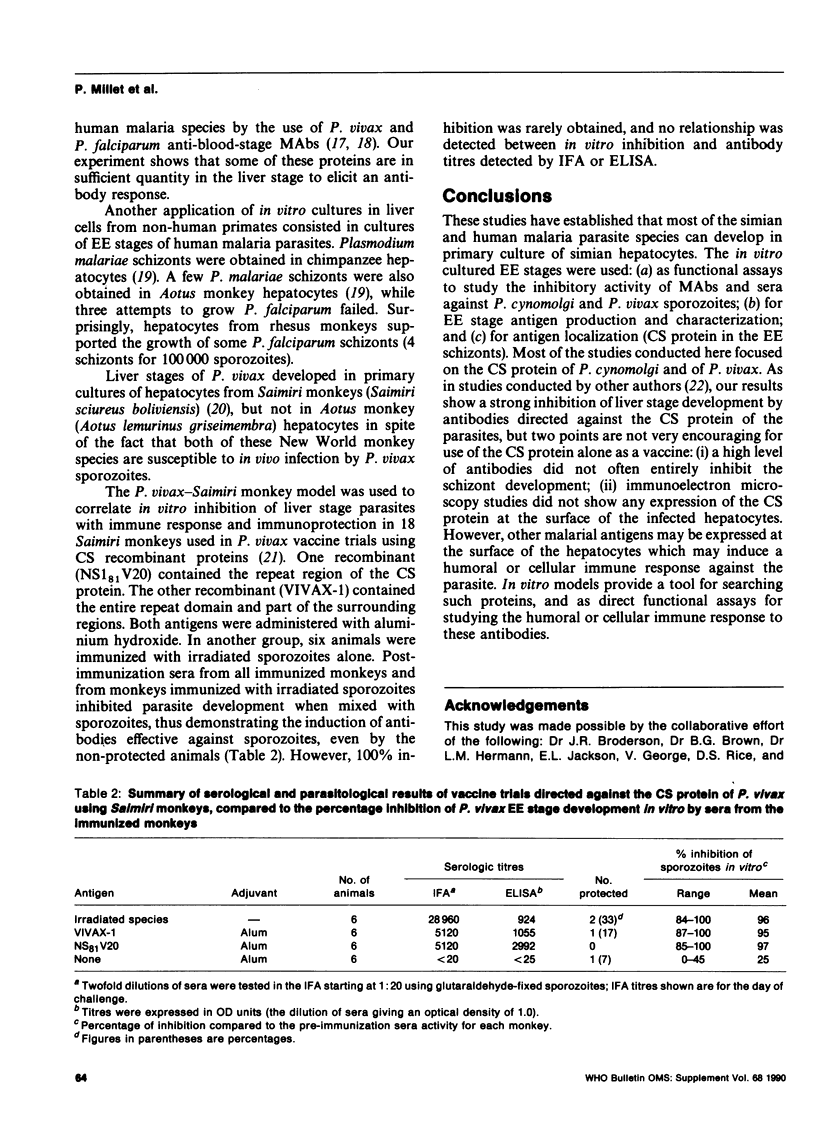
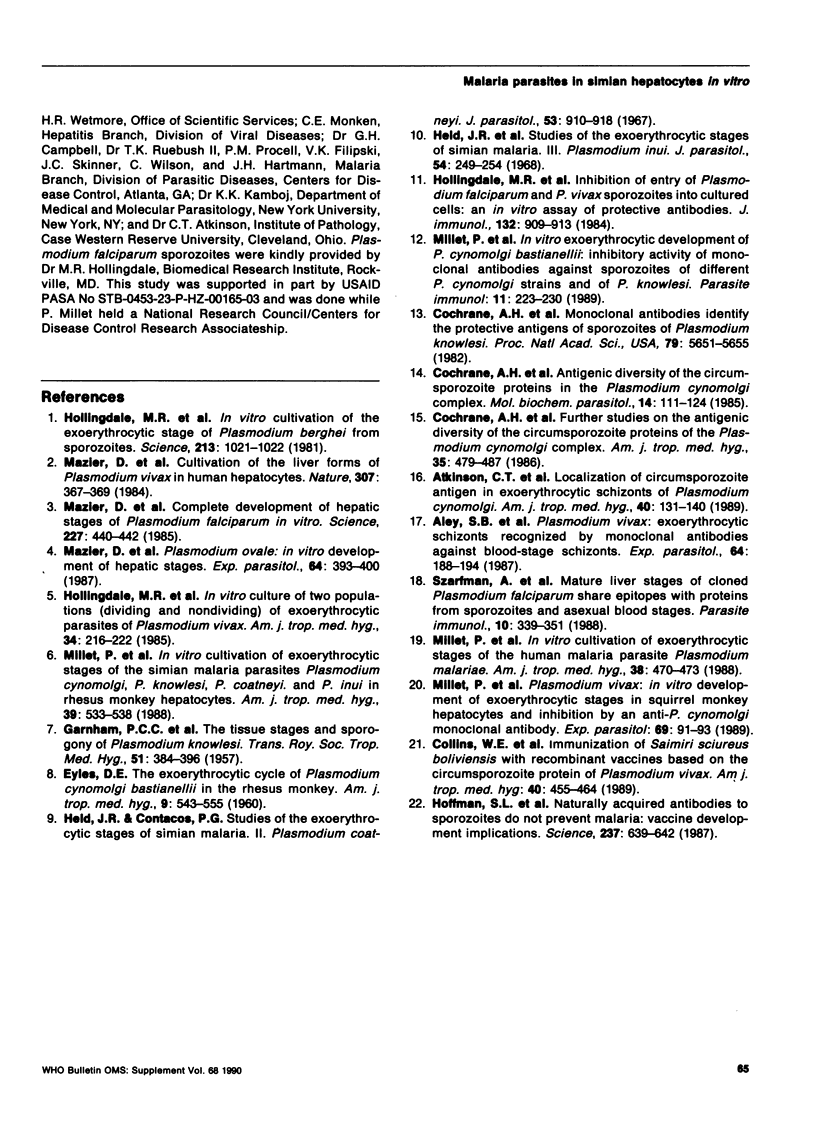
Images in this article
Selected References
These references are in PubMed. This may not be the complete list of references from this article.
- Aley S. B., Barnwell J. W., Bates M. D., Collins W. E., Hollingdale M. R. Plasmodium vivax: exoerythrocytic schizonts recognized by monoclonal antibodies against blood-stage schizonts. Exp Parasitol. 1987 Oct;64(2):188–194. doi: 10.1016/0014-4894(87)90142-1. [DOI] [PubMed] [Google Scholar]
- Cochrane A. H., Gwadz R. W., Barnwell J. W., Kamboj K. K., Nussenzweig R. S. Further studies on the antigenic diversity of the circumsporozoite proteins of the Plasmodium cynomolgi complex. Am J Trop Med Hyg. 1986 May;35(3):479–487. doi: 10.4269/ajtmh.1986.35.479. [DOI] [PubMed] [Google Scholar]
- Cochrane A. H., Gwadz R. W., Ojo-Amaize E., Hii J., Nussenzweig V., Nussenzweig R. S. Antigenic diversity of the circumsporozoite proteins in the Plasmodium cynomolgi complex. Mol Biochem Parasitol. 1985 Jan;14(1):111–124. doi: 10.1016/0166-6851(85)90110-0. [DOI] [PubMed] [Google Scholar]
- Cochrane A. H., Santoro F., Nussenzweig V., Gwadz R. W., Nussenzweig R. S. Monoclonal antibodies identify the protective antigens of sporozoites of Plasmodium knowlesi. Proc Natl Acad Sci U S A. 1982 Sep;79(18):5651–5655. doi: 10.1073/pnas.79.18.5651. [DOI] [PMC free article] [PubMed] [Google Scholar]
- Collins W. E., Nussenzweig R. S., Ballou W. R., Ruebush T. K., 2nd, Nardin E. H., Chulay J. D., Majarian W. R., Young J. F., Wasserman G. F., Bathurst I. Immunization of Saimiri sciureus boliviensis with recombinant vaccines based on the circumsporozoite protein of Plasmodium vivax. Am J Trop Med Hyg. 1989 May;40(5):455–464. doi: 10.4269/ajtmh.1989.40.455. [DOI] [PubMed] [Google Scholar]
- EYLES D. E. The exoerythrocytic cycle of Plasmodium cynomolgi and P. cynomolgi bastianellii in the rhesus monkey. Am J Trop Med Hyg. 1960 Nov;9:543–555. doi: 10.4269/ajtmh.1960.9.543. [DOI] [PubMed] [Google Scholar]
- GARNHAM P. C., LAINSON R., COOPER W. The tissue stages and sporogony of Plasmodium knowlesi. Trans R Soc Trop Med Hyg. 1957 Sep;51(5):384–396. doi: 10.1016/0035-9203(57)90071-8. [DOI] [PubMed] [Google Scholar]
- Held J. R., Contacos P. G. Studies of the exoerythrocytic stages of simian malaria. II. Plasmodium coatneyi. J Parasitol. 1967 Oct;53(5):910–918. [PubMed] [Google Scholar]
- Hoffman S. L., Oster C. N., Plowe C. V., Woollett G. R., Beier J. C., Chulay J. D., Wirtz R. A., Hollingdale M. R., Mugambi M. Naturally acquired antibodies to sporozoites do not prevent malaria: vaccine development implications. Science. 1987 Aug 7;237(4815):639–642. doi: 10.1126/science.3299709. [DOI] [PubMed] [Google Scholar]
- Millet P., Collins W. E., Fisk T. L., Nguyen-Dinh P. In vitro cultivation of exoerythrocytic stages of the human malaria parasite Plasmodium malariae. Am J Trop Med Hyg. 1988 May;38(3):470–473. doi: 10.4269/ajtmh.1988.38.470. [DOI] [PubMed] [Google Scholar]
- Millet P., Collins W. E., Herman L., Cochrane A. H. Plasmodium vivax: in vitro development of exoerythrocytic stages in squirrel monkey hepatocytes and inhibition by an anti-P. cynomolgi monoclonal antibody. Exp Parasitol. 1989 Jul;69(1):91–93. doi: 10.1016/0014-4894(89)90174-4. [DOI] [PubMed] [Google Scholar]
- Millet P., Kamboj K. K., Cochrane A. H., Collins W. E., Broderson J. R., Brown B. G., Nguyen-Dinh P. In-vitro exoerythrocytic development of Plasmodium cynomolgi bastianellii: inhibitory activity of monoclonal antibodies against sporozoites of different P. cynomolgi strains and of P. knowlesi. Parasite Immunol. 1989 May;11(3):223–230. doi: 10.1111/j.1365-3024.1989.tb00661.x. [DOI] [PubMed] [Google Scholar]
- Szarfman A., Lyon J. A., Walliker D., Quakyi I., Howard R. J., Sun S., Ballou W. R., Esser K., London W. T., Wirtz R. A. Mature liver stages of cloned Plasmodium falciparum share epitopes with proteins from sporozoites and asexual blood stages. Parasite Immunol. 1988 May;10(3):339–351. doi: 10.1111/j.1365-3024.1988.tb00225.x. [DOI] [PubMed] [Google Scholar]



